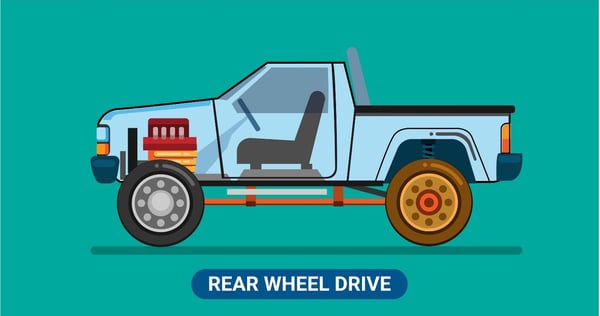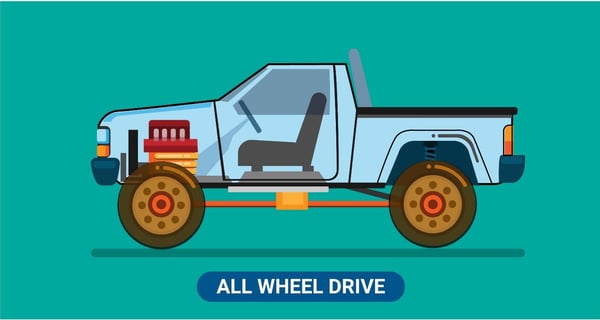Your vehicle has four wheels, but how many do you need (or want) to be powered by the engine? All of them or just a couple? And if it’s just a couple, should they be at the front or the back?
These are crucial questions that you must answer before purchasing a vehicle. Knowing the type of powertrain your vehicle has will help you get the best out of it in all conditions in the long run.
If you’re in the market for a new vehicle, navigating powertrains can be tricky. There are four different options for how your car or truck can drive its wheels—and each has its pros and cons.
So, what is the difference between FWD, RWD, AWD, and 4WD? Read on to find the answer that’ll help you brush up on some powertrain terminology and make your decision.
What is front-wheel drive (FWD)
Front-wheel drive or FWD is usually the easiest and least expensive powertrain for any vehicle.
In these vehicles, the engine is at the front, which means that there’s no need for a long and heavy driveshaft that runs under the vehicle to the rear axle.

The system is simpler, and its lighter weight helps improve fuel economy. The weight of the engine over the front axle gives good traction to the driving wheels too.
CAA PRO TIP: When driving an FWD vehicle, in case your car starts to skid, get your foot off the gas pedal as the more you accelerate the higher the wheel spin will be.
What is rear-wheel drive (RWD)
Rear-wheel drive or RWD is when the rear wheels do the pushing. This way the front wheels can apply all their available friction to help you steer better.
An RWD car is normally more responsive, agile, and more fun to drive as compared to an FWD car.

An RWD vehicle is also better at hauling heavy loads than its FWD counterpart since pushing from the rear is more effective than pulling with the front.
And finally, the heavier weight at the back means there’s more traction for towing as well.
What is all-wheel drive (AWD)
All-wheel drive or AWD is where one gets the best of all driving worlds as all four tires share the demand for acceleration. The torque converter can send the engine’s power to both sides of the axle at will.
This allows for better traction on snowy or wet roads, and performance cars can distribute their power more directly to whichever wheels (front or back) can make the best use of it.

However, AWD systems are heavier and more complicated, which can affect fuel consumption and maintenance costs. And while many drivers think they can brake better, AWD does little to help slow down your vehicle in slippery conditions.
To save fuel, most AWD vehicles drive power only to the front or rear wheels under normal conditions. When the road gets slippery or if you need quicker acceleration, the extra traction of the second pair of wheels is activated automatically, and instantly, to whatever strength is optimal.
Most systems can send up to half their power to the second axle, while some can also send power to just one wheel, if needed, in a slippery situation.
CAA PRO TIP: Sometimes despite a vehicle having an AWD powertrain, it can have trouble getting out of thick snow. In such cases, it’s helpful if you dig out some of the snow from behind each tire using a shovel and then accelerating your vehicle out of there using its AWD power.
What is four-wheel drive (4WD)
The term “four-wheel-drive” or 4WD is becoming less common nowadays.
These days 4WD usually refers to off-road vehicles with transfer cases that can switch the gears between high and low settings. For example, Jeeps and Land Rovers.
Previously, any vehicle that always powered all four of its wheels would be considered 4WD.
However, these days, some AWD vehicles will always send at least 10 percent of their driving power to the second axle—to be ready when it might be needed on an unexpectedly slippery road.
Ready to hit the road? Don’t leave without CAA
Now that you have all the information necessary to help you make an informed decision about which powertrain you should choose, it’s time to protect yourself once you hit the road as well.
For just $8 a month, you can get yourself a CAA membership and enjoy peace of mind when you’re on your road adventures. Always have the confidence to explore more, no matter what the terrain.
One of the benefits of being a CAA member is that you don’t need to be stuck to just one vehicle as your membership will follow, protect, and cover you and not your vehicle.
Therefore, no matter whether you’re driving an FWD, RWD, AWD, or 4WD, you will always have the luxury to enjoy uninterrupted roadside assistance whenever, wherever you ask for it.
If you’re still not sure which powertrain is right for you, talk to the experts today at CAA Battery Depot, or a CAA Approved Auto Repair Service (AARS) partner.


